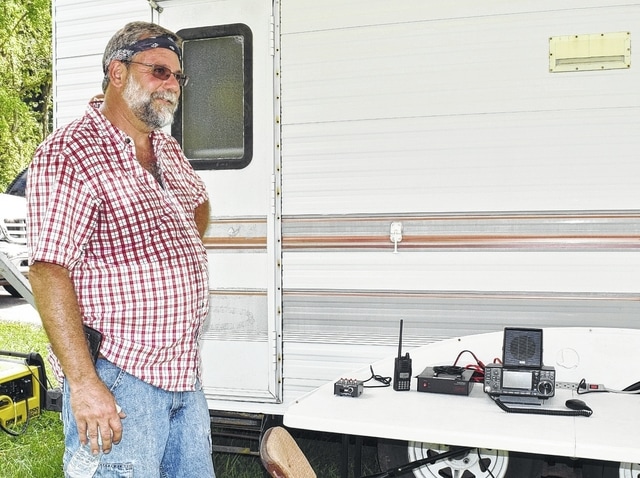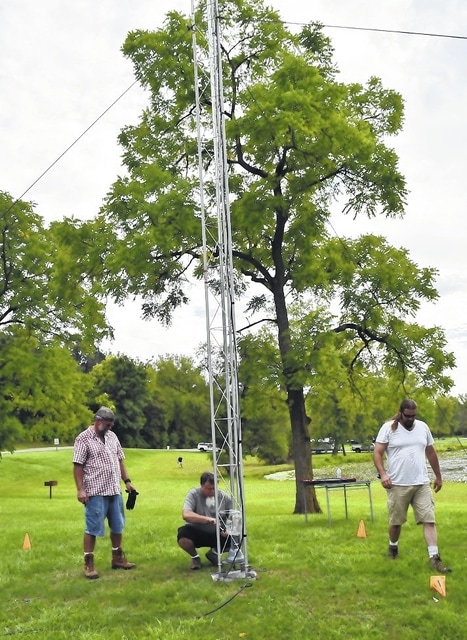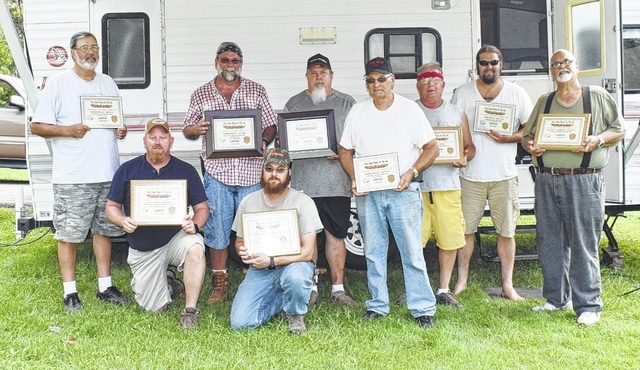


ST. PARIS – For eight hours on Saturday, local amateur radio enthusiasts worked in teams to make contact with as many people as possible.
Several members of the Champaign Logan Amateur Radio Club spent their afternoon and evening in Kiser Lake State Park contacting other ham radio members worldwide as part of the Ohio State Parks On the Air contest. Amateur radio groups gather in the Ohio state parks to take part.
Amateur, or “ham” radio, is radio technology not connected to a cell phone network or the internet. Users must be licensed by the Federal Communications Commission (FCC) and each has an FCC-assigned call sign. And although the communication is over radio waves, it can be visual, audio or text, and the range is global, local contest organizer and Urbana resident Wayne Brunotte said.
The local group won the contest five of the past eight years, he said. The results of Saturday’s contest won’t be known for a couple of months.
“If it wasn’t for amateur radio, they wouldn’t have ever discovered cellphones and so on,” Brunotte said. “The government really holds amateur radio in high regard because they know we’ll always be able to communicate.”
Ham radio can operate if all other communications technology is down, as long as there is a power source, Brunotte said. The radios can be powered by batteries fueled by a generator or solar power; they don’t just have to be plugged into an outlet.
“This is good practice for an emergency,” Brunotte said. “When everything else fails, ham radio will be the last thing you can communicate with. We have quadruple redundancy. Plus we all have home stations.”
When there are hurricanes, ham radio enthusiasts establish networks for people to check on loved ones who may be in the path of the hurricane.
On Sept. 11, 2001, cell phone networks were jammed as people checked on relatives in New York City, but ham radio was not clogged by phone or text traffic, Mechanicsburg resident Rick Weber said.
Ham radio enthusiasts can contact the International Space Station if they wish, as it has a ham radio on board, Brunotte said.
Competition and camaraderie
“What I like about what we’re doing here is it’s like a radio sport. It’s competitiveness. Plus, along with that, we get the ability to practice these setups in case it’s ever needed in an emergency,” Brunotte said of the weekend competition.
Brunotte, a process manufacturing engineer at Honeywell, got interested in radio at age 15. He started out on the CB, or “Citizens Band,” which is a different frequency and doesn’t require an FCC license to use. He moved into ham radio to expand his knowledge. His call sign is AB8DD, and it was that call sign used Saturday for all of the club’s contacts in the contest.
“It’s exciting to me, meeting new people, meeting people with similar interests,” he said.
Urbana resident Judah Risner, call sign KE8BCA, got into ham radio a little over a year ago, when he and his father-in-law got in touch with someone who trained people to get licensed. Risner, a materials supply chain worker at Navistar, said he loves the ability to talk to others and work with others on his hobby.
“There’s a lot of camaraderie,” he said. “I like the fact that there’s a good survival aspect to it. If all your cell phones go down, this will still work. It’s not reliant on a service. It does need power, but that can be solar, or a generator, or something you’ve made yourself. It doesn’t have to be electric plugged into an outlet.”
Ham radio has always interested Larry Haverkos of Urbana. The retired Urbana University professor first learned about ham radio when he was a kid. One of his neighbors was a ham radio operator.
“He had a setup in his attic and he let me come and look at it,” he said. “It always fascinated me. I thought I would do it, but I never had time. When I retired, I figured this would be something good to do. It was a totally new learning curve.”
Haverkos, whose call sign is K8UUU, taught sociology and cultural anthropology at Urbana University. He said he didn’t know anything about electronics, but the other operators in the club helped him figure it all out.
“I had no idea how hard it is,” he said. “Things you can learn pretty quickly when you are 12, but in the late 60s you don’t learn them so quickly.”
Collecting contacts, anything goes conversations
“It’s like somebody who collects coins or stamps or buttons or bottle caps. We collect contacts,” Brunotte said.
Some ham radio folks will take vacations with their equipment, going to places that don’t typically have someone with a ham radio, to establish contacts for their (and other people’s) collections.
Ham radio enthusiasts come from all walks of life, but they share the passion for finding those contacts.
Ham radio is open to anyone who tunes in. All conversations are over the radio waves, and all can participate if they wish.
Haverkos focuses on long distance contacts. He said he likes talking to people on the other side of the world. If you don’t speak the same language, there are simple radio codes to establish the contact. Sometimes, Haverkos said, he will just sit and listen to a conversation.
“There are some very chatty people that will just gab. That’s fun, too,” he said.
But there is one golden rule.
“You don’t talk politics,” he said. “It’s not a law, just an observed rule. Aside from routine openers being the weather, people talk about everything.”
A lot of the participants know enough about electronics and materials that they create their own antenna and radio equipment. There are also do-it-yourself kits available.
Weber (call sign N8XIX), who works at Cisco in IP Telephony, got interested in ham radio as a result of his grandfather. His call sign was his grandfather’s. Weber likes the digital communication side of ham radio, specifically instant messaging via the radio waves. It’s like an internet chat room without the internet, he said.
“You can sit and watch somebody type to you,” he said. “It’s just coming from my radio to their radio, no internet between.”
He said one of the fun things to do is just hunt for a contact: “It’s like fishing for fish.”
And Weber is passing the hobby on to his 4-year-old son.
“He’s at that impressionable age where everything is a wonder,” he said.
For more information about ham radio, visit the National Association for Amateur Radio at www.arrl.org. For more information about the Ohio State Parks on the Air contest, visit www.ospota.org.




